The following article concerning the stamps of Antigua up until 1962 was first published in “The Australian Stamp Monthly”, September 5, 1962.
ANTIGUA LIES south-east of St. Kitts in the Leeward Islands of the A West Indies, latitude 17 deg. 6 N, longitude 61 deg. 45 W. The colony consists of the islands of Antigua, 108 square miles, Barbuda, 62 square miles, and Redonda, a rocky islet about half a square mile in extent.
Antigua is a low lying island with deeply indented shores which are lined by reefs and shoals, but contain many natural harbours. The highest ground, Boggy Peak, in the south-west, is of volcanic origin and rises to a height of 1,330 feet. Barbuda, 25 miles north of the main island, is very flat with a large lagoon on the west side, separated from the sea by a spit of sand. There are no rivers and few springs in the islands.
The principal products are sugar, cotton and molasses.
Antigua was discovered by Christopher Columbus in the year 1493 on his second voyage to the West Indies. He named the island after the church of Santa Maria de la Antigua, in Seville.
The Spaniards attempted to settle in 1520, but they found it too dry. In 1629, a French party under d’Esnambuc made an attempt at settlement, but abandoned it in favour of the richer soil of St. Kitts.
Antigua was eventually colonised from St. Kitts in the year 1632 by Sir Thomas Warner and his son, having previously been taken under Royal protection by patent under the Great Seal of England on September 13, 1625. In the early years, the settlers suffered much from raids by the Caribs.
At that time the chief crop was tobacco, but between 1640 and 1647 the sugar industry was introduced to the islands and was found to be more profitable. This required heavy labour and, at first, the defeated armies in the English Civil Wars were sent as slaves or indentured workers to the plantations in the West Indies, but when these were found to give indifferent results in the tropical climate, the trade in slaves from Africa began and it was at its height throughout the 18th century. The operation of sugar estates became extremely profitable and the wars between the English and French were much concerned with the possession of the sugar islands.
Though in 1666 Antigua was invaded and plundered by the French, the island never passed out of British hands and shows no signs of French influence. By the Treaty of Breda in 1667 Antigua was declared to be English.
Antigua was the only British island to possess a good harbour and English Harbour was the dockyard for the British West Indies from 1725. It was the headquarters of Nelson when he was Senior Captain in charge of the northern division of the Leeward Islands Station. After the Napoleonic Wars the dockyard declined in importance and was closed in 1854.
Antigua emancipated its slaves in 1834, four years before the rest of the British Empire and this led at first to some difficulty in obtaining labour for the sugar estates. A disastrous fire in 1841, an earthquake which destroyed the Cathedral in 1843, the year after the diocese of Antigua was formed, and a hurricane which did £100,000 damage in 1847 were serious economic blows and there have since been several periods of relative prosperity and depression according to the price of sugar.
In 1871, the Leeward Islands Federation was formed and this lasted until 1956, when the Presidencies were reconstituted as separate colonies.
The first postage stamps to be used in Antigua were the 1d., 2d., 4d., 6d. and 1/- values of Great Britain issued between 1856 and 1858. These stamps were used at St. John’s with a cancellation reading A02 and at English Harbour with the cancellation A18.
Pictured, Antigua 1862 ½d. and 1d.
Early in 1861, a request was received by Perkins, Bacon & Co. from one William Houghton, of 162 New Bond Street, to supply an estimate for the preparation of postage plates for Antigua. The estimate, which was for 1d. and 6d. values, was eventually accepted and the 6d. value was printed and released in August, 1862. The stamp was printed on unwatermarked paper in a rather severe recess engraved design. The 1d. value in the same design was released in January, 1863, and various reprints of both values took place between 1864 and 1867. These printings were on paper watermarked with a small star.
In October, 1868, Mr. Houghton, of New Bond Street, entered into partnership with Charles H. Gunn, and the new firm of Houghton and Gunn wrote to Perkins, Bacon & Co. in July, 1871, asking them to “discontinue supply of Antigua Postage stamps until further orders.” In November of that year, Houghton and Gunn, at the request of the Crown Agents, asked Perkins. Bacon & Co. to send the plates, dies and transfer rollers to New Bond Street, which they did. Houghton and Gunn handed them over to the Crown Agents and, on November 29, Thomas De La Rue & Co. were requested by the Crown Agents to provide for the Government of Antigua, 550 sheets of the 1d. and 250 sheets of the 6d. value. The stamps were printed on Crown CC watermarked paper and were released in 1872. A further printing of both values was released in 1876.
The Leeward Islands Colony had been created in 1871, and on May 15, 1879, the Auditor General of the Leeward Islands wrote to the Colonial Secretary in London, drawing his attention to the fact that the Colony would be admitted to the Universal Postal Union in July, 1880, and that it would “be necessary to provide postage stamps for the several Presidencies to suit the changes in the rates of postage.” The Auditor General went on to suggest “that it would be more economical to have one postage stamp for the Leeward Islands with an initial letter to denote the Presidency from which it was issued (so long as separate accounts are kept with each Presidency) unless there was an objection to use a Leeward Islands stamp conjointly with those in existence.” In the light of later events this letter is significant, and at the time it prompted the issue of stamps in the Uniform Keyplate design for the Leeward Islands with separate overprint plates for the name of the Presidency and the duty. The new stamps for Antigua were a 2½d. and a 4d. value. The stamps were printed by letterpress by Thomas De La Rue & Co. on Crown CC watermarked paper. In 1882 a ½d. value was added and a further printing of the 2½d. value took place, both on Crown watermarked paper. Between 1884 and 1886, further printings of the 1d. and 6d. values took place and in 1886 the colours of the 2½d and 4d. denominations were changed and a 1/- was added.
On January 23, 1890, the Governor of the Leeward Islands wrote to the Colonial Office proposing the unification of the stamps of the Leeward Islands Presidencies in one issue for use throughout the Colony. This proposal was accepted and from October 31, 1890, until 1903 the Leeward Islands Issue was in sole use.
Pictured, Antigua 1903 ½d. and 5/-.
In 1903, a new issue was released to be used concurrently with the Leeward Islands stamps. The issue consisted of ten values, ½d. to 5/- in two designs, each printed in two colours by letterpress by Thomas De La Rue & Co. on Crown CC watermarked paper. The design for the lower values showed the Colony Badge surmounted by the Royal Arms in a circular framework with the inscription EDWARDUS VII D.G. BRITT:OMN:REX F.D. IND. IMP. SIGIL. INSS. ANTIGUAE ET BARBUDAE around the inner edge. The title Antigua and the value appeared in ornamental panels at the top and bottom with the word Postage at one side and Revenue at the other. This was the first time the Royal Arms had appeared on a stamp. The design for the five shilling value featured a medallion portrait of King Edward VII in an ornamental framework. Reprints of the ½d., 1d. and 2½d. in 1908 were in single colours only though a further printing of the 1/- in the same year was in two colours. The 6d. was reprinted in 1911 and the 2d., 3d. and 2/- in 1912 – all in two colours and the 5/- was released in 1913 with the portrait changed to that of King George V. All these reprints were on Multiple Crown CA (Block Capitals) watermarked paper. A further printing of 1d. value was released on August 5, 1915.
Pictured, Antigua 1913 5/-.
In September, 1916, and on October 1, 1917, the ½d. value was released overprinted “WAR STAMP” in black and red, respectively, and in 1918 a new 1½d. value was released with the same overprint in black.
In 1921, the first nine values of a new definitive issue were released. The design, which was common to all values, included the Colony Badge and a medallion portrait of King George V. Again printed by letterpress by Da La Rue & Co. the ½d., 1d., 2d., 2½d., and 6d. values script CA watermark paper and the 3d., 1/-, 2/- and 2/6 values were on Crown CA (Block Capitals) paper. Six more values were released in 1922; 1½d., 3/- and 4/- on Script CA watermarked paper and 4d., 5/- and £1 on CA (Block Capitals) paper. A reprint of the 3d. in 1925 was on Script and a reprint of the 1½d. value in 1926 changed the colour from dull orange to carmine. The 2½d., 2/- and 2/6 values were reprinted in 1927 and the two latter denominations were transferred to the Script paper. Reprints of the 1d., 1½d. and 1/- took place in 1929; the colour of the 1½d. was changed to pale redbrown and the 1/- was printed on Script paper. Further printings of the 1d. and 2½d. values changed the colours from scarlet to violet and from blue to orange-yellow, respectively.
Pictured, Antigua 1921 ½d.
1932 saw the issue of ten stamps to commemorate the Tercentenary of the Colony. Released on January 27, the design for the highest value was by Mrs. J. Goodwin and that for the other values by Waterlow & Sons, who printed the stamps by the recess process on Script CA watermarked paper. The ½d., 1d. and 1½d. values featured the Old Dockyard at English Harbour, the 2d., 2½d. and 3d. values showed Government House, St. John’s, and the 6d., 1/- and 2/6 stamps depicted the last visit of Nelson in 1805 and showed H.M.S. “Victory” leaving St. John’s on her way to Trafalgar. Each of these three designs included an inset portrait of the King and the dates 1632-1932. The 5/- value showed Sir Thomas Warner’s ship viewed through a colonnade formed of three Ionic arches. The date of the colonisation by Sir Thomas Warner, 1632, was shown on the floor of the colonnade and the dates 1732, 1832 and 1932 were inscribed on the lintels of the arches. The St. Edward’s Crown surmounted the nearest arch and was flanked by two aeroplanes, indicative of modern times.
Pictured, Antigua 1932. Top, ½d. and 2d. Bottom, 6d. and 5/-.
The Colony took part in the general releases for the Silver Jubilee of King George V in 1935 and the Coronation of King George VI in 1937.
Pictured, Antigua 1938. Top, ½d. and 1d. Bottom, 3d. and 6d.
On November 15,1938, the new definitive issue for King George VI was released. This consisted of ten values, ½d. to 5/-, in four designs, and was recess engraved by Waterlow & Sons on Script CA watermarked paper. The scenes depicted were all of historical interest and the aeroplane on the 6d. value indicated that it was intended primarily for air mail.
Victory was commemorated in 1946 as part of the general issue and in 1948 new 10/- and £1 values were added to the definitive issue.
The Colony took part in the issues for the Royal Silver Wedding and the 75th Anniversary of Universal Postal Union in 1949, the Inauguration of the University College of the West Indies in 1951 and the Coronation of Queen Elizabeth II in 1953. The University College commemorative was the first issue of Antigua to be in dollar currency, the values were 3 and 12 cents.
Pictured, Antigua 1953 8d.
The new definitive issue for Queen Elizabeth II was released on November 2, 1953, and consisted of fourteen values from 1 cent to $4.80. The designs were the same as for the previous issue, with one addition which featured a Martello Tower and were again recess engraved by Waterlow and Sons on Script CA watermarked paper. A ½ cent value was added on July 3, 1956.
Antigua joined in the general release to commemorate the Inauguration of the West Indies Federation in 1958.
A new constitution was granted to the Colony in 1960, and to commemorate this event the 3 and 12 cents values of the definitive issue were released on January 1 of that year with the overprint “Commemoration Antigua Constitution 1960.”
On November 14, 1961, a special issue was released to commemorate the Restoration of Nelson’s Dockyard at English Harbour. The issue consisted of two values, 20 and 30 cents, in a common design which featured a view of the restored Dockyard and an adaptation of a portrait of Lord Nelson by L. F. Abbott, together with the Annigoni portrait of the Queen and the St. Edward’s Crown. The stamps were printed by Bradbury, Wilkinson & Co. Ltd. on CA (Block Capitals) watermarked paper.
Pictured, Left 1961 20 cents, Right 1962 3 cents.
On August 1, 1962, the Government of Antigua will release four stamps to commemorate the centenary of their first stamp issue in August, 1862. The stamps have been printed by Bradbury, Wilkinson & Co. Ltd. on CA. (Block Capitals) watermarked paper in horizontal format, size 42 mm. x 27 mm. The design, which is common to all values, includes the Annigoni portrait of Her Majesty the Queen and features the original 6d. stamp inset above a view of English Harbour with a Royal Mail Steam packet of 1862 in the foreground. The values and colours are:-
3 cents Green and purple.
10 cents Green and blue.
12 cents Green and black.
50 cents Green and orange-brown







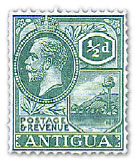

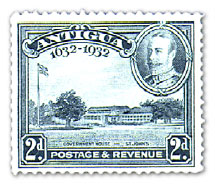

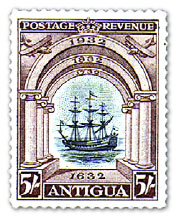



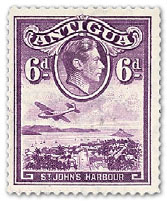
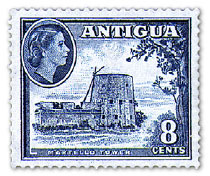

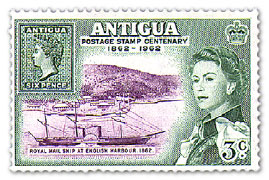





What is the meaning of “Barbuda Mail” overprinted on so many Antigua and Barbuda stamps?
I would be very grateful for an answer to this question.
Thank you very much
I have a few Antiguan postage stamps (collected when I served in the Royal Navy) and one is from a collection from 1953, a 12c stamp, crossed out and overprinted with 15c. Could you tell me anything about? Or if it has any value.
Thank you.
Regards
dennis snape
In mid 40’s as a young lad I remember in my father’s stamp collection there was a stamp marked as ANTIGUA . At that time I was not aware that it was the name of an Island. The prominent feature of the stamp was a marble column, Antigua printed under the column (I think), but cannot remember the background.
I have been trying to find more about it, on an off, at least for some 30 years. And today finally found a listing of “Postage Stamps of Antigua (1856-1962)”. But the marble column is not there. Would you be able help me find where I may find more about it?
Thanks in advance,
Jim O.
For a useful history on Antigua nad Barbuda, visit http://en.wikipedia.org/wiki/History_of_Antigua_and_Barbuda.
i have 3 penny blacks stamps with red stamp on 2 of them what does this mean
I have an Antigua sovenir sheet with Redonda printed on it………….Scott #513 what is the difference from the Antigua without Redonda printed?